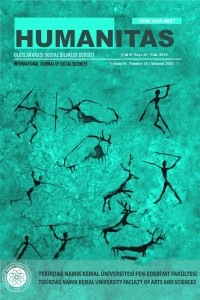Öz
In order to analyze the adaptation process, which means transferring a work written in one medium to another, it is necessary to grasp the narrative possibilities of both mediums included in this process. It is not possible to fully preserve elements such as long and detailed descriptions, intricate plot, characters, time, place and the narrator present in the novel while transferring it to the graphic novel. During the adaptation process, due to the structure of the graphic novel, these can be shortened and presented to the reader. Here, the graphic novel should not be considered as a different novel from the source work. In graphic novel adaptation, there is a new creation depending on the source work by using visual elements such as drawings and speech bubbles. In this study, Ayşe Kulin's novel named as Veda Esir Şehirde Bir Konak is compared with the graphic novel adaptation created by the drawings of Cemil Cahit Yavuz. In the comparison stage, theoretically descriptive theory and semiotics were used.
Anahtar Kelimeler
Kaynakça
- Aktaş, Ş. (1984). Roman sanatı ve roman incelemesine giriş (1. baskı). İstanbul: Birlik Yayınları.
- Cohn, N. (2013). The visual language of comics introduction to the structure and cognition of sequential images (1. baskı). London: Bloomsbury.
- Forster, E. M. (1985). Roman sanatı (2. baskı). (Ü. Aytür, Çev.). İstanbul: Adam Yayınları. (Orijinal çalışma basım tarihi 1956).
- Gönenç, L. (2010). Grafik roman. Varlık, 1232, 11-14.
- Gürdağarcık, S. (1985). Çizgi romanın öyküsü. Gösteri, 61, 66-68.
- Kongar, E. (1985). Çizgi roman ve eğitimdeki rolü. Gösteri, 61, 78-80.
- Kulin, A. (2010). Veda (1. baskı). İstanbul: Everest Yayınları.
- Kulin, A. (2014). Veda (53. Baskı). İstanbul: Everest Yayınları.
- Platin, A. (1985). Tek resimden dizi resme geçiş. Gösteri, 61, 64-65.
- Rifat. M. (1982). Göstergebilim kuramları. Yazko Çeviri, 1, 9, 119-126.
- Rifat. M. (2005). XX Yüzyılda dilbilim ve göstergebilim kuramları (3. baskı). İstanbul: Yapı Kredi Yayınları.
- Sağlık, E. (2010). Popüler roman estetik roman (1. baskı). Ankara: Akçağ Yayınları.
- Şenbay, N. (2015). Söz ve diksiyon sanatı (32. baskı). İstanbul: Yapı Kredi Yayınları.
- Toury, G. (1995). Descriptive translation studies and beyond (1. baskı). Amsterdam: John Benjamins.
- Tuncer, N. (1993). Çizgi roman ve çocuk (1. baskı). İstanbul: Çocuk Vakfı Yayınları.
Öz
Herhangi bir türde yazılmış yapıtı başka türe aktarma anlamına gelen uyarlama sürecinin çözümlenebilmesi için bu sürece dâhil olan her iki türün anlatım olanaklarını kavramak gerekir. Romanda var olan uzun betimlemeler, ayrıntılı tasvirler, girift olay örgüsü, zengin kişi kadrosu, zaman, mekân ve anlatıcı gibi unsurların; grafik romana aktarılırken aynen korunması mümkün değildir. Bunlar, uyarlama sırasında, grafik romana özgü bir biçimde kısaltılarak okuyucuya sunulabilir. Burada grafik romanın kaynak eserden uzaklaştığı düşünülmemelidir. Grafik roman uyarlamasında, çizimler, konuşma balonları gibi görsel ögeler kullanılarak kaynak esere bağlı yeni bir yaratım söz konusudur. Bu çalışmada, Ayşe Kulin’in Veda Esir Şehirde Bir Konak adlı romanı, Cemil Cahit Yavuz’un çizimleriyle oluşturulan grafik roman uyarlaması ile karşılaştırılmıştır. Karşılaştırma aşamasında teorik olarak betimleyici kuram ve göstergebilimden faydalanılmıştır.
Anahtar Kelimeler
Kaynakça
- Aktaş, Ş. (1984). Roman sanatı ve roman incelemesine giriş (1. baskı). İstanbul: Birlik Yayınları.
- Cohn, N. (2013). The visual language of comics introduction to the structure and cognition of sequential images (1. baskı). London: Bloomsbury.
- Forster, E. M. (1985). Roman sanatı (2. baskı). (Ü. Aytür, Çev.). İstanbul: Adam Yayınları. (Orijinal çalışma basım tarihi 1956).
- Gönenç, L. (2010). Grafik roman. Varlık, 1232, 11-14.
- Gürdağarcık, S. (1985). Çizgi romanın öyküsü. Gösteri, 61, 66-68.
- Kongar, E. (1985). Çizgi roman ve eğitimdeki rolü. Gösteri, 61, 78-80.
- Kulin, A. (2010). Veda (1. baskı). İstanbul: Everest Yayınları.
- Kulin, A. (2014). Veda (53. Baskı). İstanbul: Everest Yayınları.
- Platin, A. (1985). Tek resimden dizi resme geçiş. Gösteri, 61, 64-65.
- Rifat. M. (1982). Göstergebilim kuramları. Yazko Çeviri, 1, 9, 119-126.
- Rifat. M. (2005). XX Yüzyılda dilbilim ve göstergebilim kuramları (3. baskı). İstanbul: Yapı Kredi Yayınları.
- Sağlık, E. (2010). Popüler roman estetik roman (1. baskı). Ankara: Akçağ Yayınları.
- Şenbay, N. (2015). Söz ve diksiyon sanatı (32. baskı). İstanbul: Yapı Kredi Yayınları.
- Toury, G. (1995). Descriptive translation studies and beyond (1. baskı). Amsterdam: John Benjamins.
- Tuncer, N. (1993). Çizgi roman ve çocuk (1. baskı). İstanbul: Çocuk Vakfı Yayınları.
Ayrıntılar
| Birincil Dil | Türkçe |
|---|---|
| Bölüm | Tüm Sayı |
| Yazarlar | |
| Yayımlanma Tarihi | 15 Ekim 2020 |
| Yayımlandığı Sayı | Yıl 2020 Cilt: 8 Sayı: 16 |









